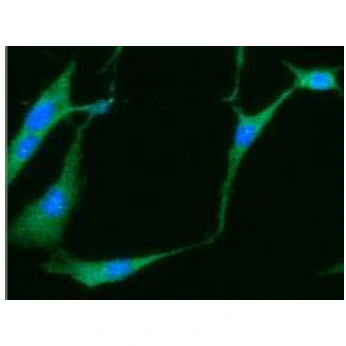NSE antibody [C1C3]
GTX113428
ApplicationsImmunoFluorescence, Western Blot, ImmunoCytoChemistry, ImmunoHistoChemistry, ImmunoHistoChemistry Frozen, ImmunoHistoChemistry Paraffin
Product group Antibodies
TargetENO2
Overview
- SupplierGeneTex
- Product NameNSE antibody [C1C3]
- Delivery Days Customer9
- Application Supplier NoteWB: 1:1000-1:10000. ICC/IF: 1:100-1:1000. IHC-Fr: 1:100-1:1000. *Optimal dilutions/concentrations should be determined by the researcher.Not tested in other applications.
- ApplicationsImmunoFluorescence, Western Blot, ImmunoCytoChemistry, ImmunoHistoChemistry, ImmunoHistoChemistry Frozen, ImmunoHistoChemistry Paraffin
- CertificationResearch Use Only
- ClonalityPolyclonal
- Concentration1 mg/ml
- ConjugateUnconjugated
- Gene ID2026
- Target nameENO2
- Target descriptionenolase 2
- Target synonymsHEL-S-279, NSE, gamma-enolase, 2-phospho-D-glycerate hydro-lyase, 2-phospho-D-glycerate hydrolyase, enolase 2 (gamma, neuronal), epididymis secretory protein Li 279, neural enolase, neuron specific gamma enolase, neuron-specific enolase, neuronal enriched enolase, neurone-specific enolase
- HostRabbit
- IsotypeIgG
- Protein IDP09104
- Protein NameGamma-enolase
- Scientific DescriptionThis gene encodes one of the three enolase isoenzymes found in mammals. This isoenzyme, a homodimer, is found in mature neurons and cells of neuronal origin. A switch from alpha enolase to gamma enolase occurs in neural tissue during development in rats and primates. [provided by RefSeq]
- Storage Instruction-20°C or -80°C,2°C to 8°C
- UNSPSC12352203
References
- Cortés-Medina LV, Pasantes-Morales H, Aguilera-Castrejon A, et al. Neuronal Transdifferentiation Potential of Human Mesenchymal Stem Cells from Neonatal and Adult Sources by a Small Molecule Cocktail. Stem Cells Int. 2019,2019:7627148. doi: 10.1155/2019/7627148Read this paper


![ELISA analysis of antigen using GTX60625 NSE antibody [5D3]. Black : Control antigen 100ng Purple : Antigen 10ng Blue : Antigen 50ng Red : Antigen 100ng](https://www.genetex.com/upload/website/prouct_img/normal/GTX60625/GTX60625_20170912_ELISA_w_23061123_381.webp)


